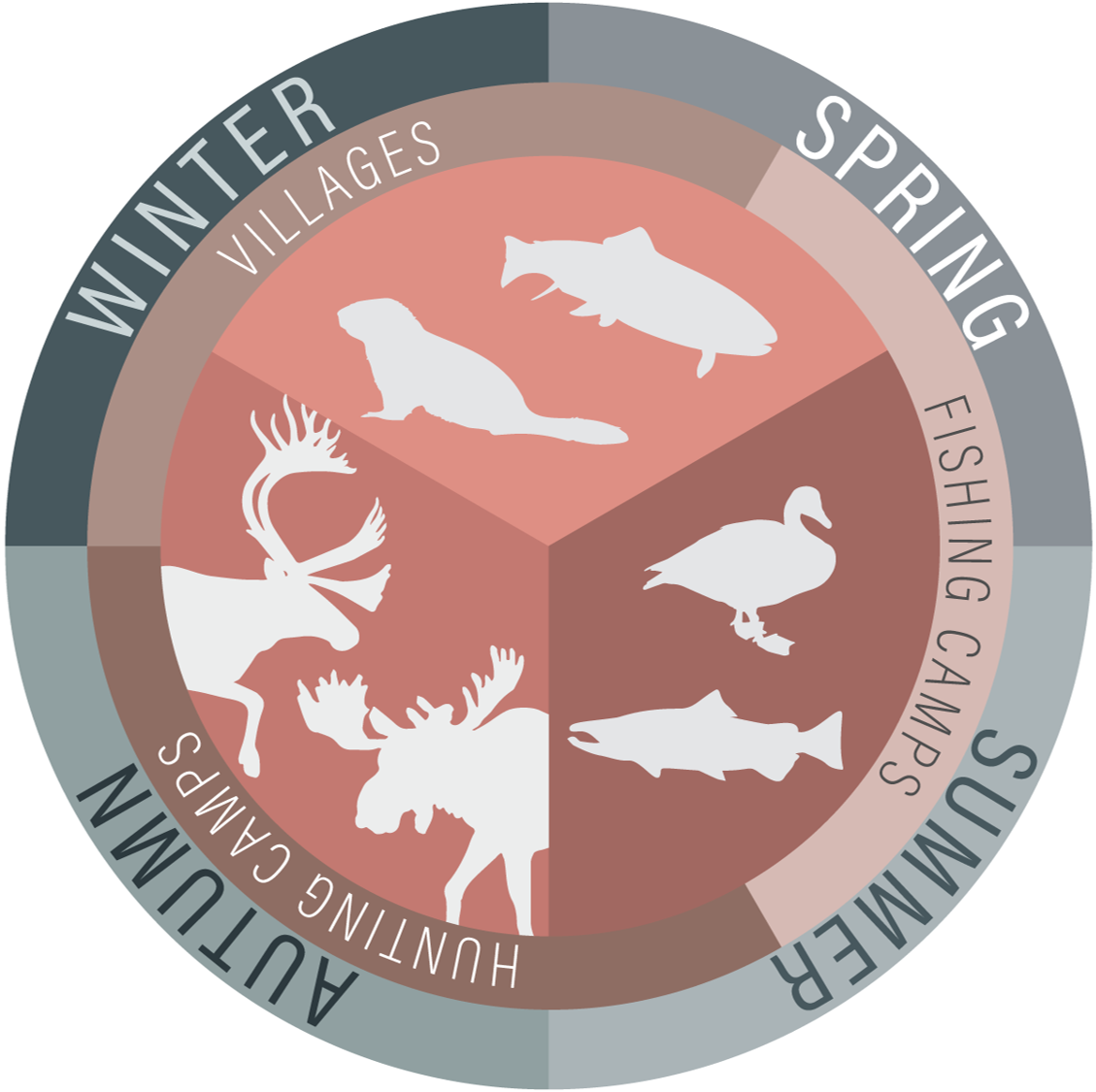1867 INTERIOR ALASKA: A HISTORY IN OBJECTS
The 1867 Treaty of Cession transferred possession of Alaska to the United States. The majority of the Western historical and anthropological research relating to this time period has focused on the cultures of Southeast and Southcentral Alaska, where the Russians primarily focused their colonization efforts. This exhibition highlights the under-represented vibrant, complex and resilient cultures of Interior Alaska during this same time period. Past Athabascan lifeways in interior Alaska are understood from archaeological sites, artifacts, and oral history.
A TIME OF CHANGE
FOLLOWING THE SEASONS
The climate in Interior Alaska is highly variable with seasonal extremes. Plants and animals are available at different times and places within the Interior. Athabascan activities and economy followed the seasons, and the abundance and migration patterns of animals.

During the summer months (June, July, and August) the primary focus was on obtaining stores of dried fish, salmon, pike, burbot and whitefish to eat during the winter.
In the fall (September and October) when the fishing season was over, but before the rivers and lakes froze, people turned their attention toward hunting. Caribou were the main focus of fall hunting and caching activity and camps were often placed in the uplands between the Tanana and Yukon Rivers. Waterfowl were hunted during their fall migration south, and often camps were set up near lakes where these birds would congregate. Berry picking, trapping muskrat, and hunting moose and sheep were also important subsistence activities but were conducted more opportunistically either during or in between fishing and hunting waterfowl and/or caribou.

Winter months (November, December, and January) were spent in more permanent camps set up near cached fish and meat. As the surplus of stored food dwindled winter camps were vacated for the late winter season (February and March) as people traveled the countryside searching for wild game. With the onset of spring (April and May) camps would be set up, often near a large lake, in order to fish and hunt returning migratory waterfowl, small mammals, and moose.
Precontact Technology and Settlements
The material culture of Alaska Natives prior to widespread contact with Westerners was complex and used a variety of stone, bone, wood and metal resources. What archaeologists term “the Athabascan tradition” begins around 1500 years ago. It is marked by a shift towards bow and arrow technology with the reliance on bone and antler tools, introduction of native copper items, decorative items (including trade items such as beads and buttons), boulder spall scrapers, and bone fleshers.
Trade networks became more complex, possibly due to expansions in population around the year 1000. Chief among these traded materials was obsidian, native copper, and other prestigious items (e.g. shells) that were traded hundreds of miles from their original source. These trade goods attest to extensive exchange networks and interconnections between groups in Interior Alaska, and with groups in the Yukon and British Columbia, Canada.
Athabascan seasonal activities across the Interior were closely aligned to the abundance and migration patterns of game. The Athabascan economy, prior to direct contact with Europeans, was based on a cyclical pattern of hunting, fishing, gathering, and trade. These seasonal rounds varied by local group depending upon the availability of natural resources. Like all northern Indigenous groups, the goal of Alaskan Athabascans was to obtain a surplus of resources to last throughout the winter months.
Traditional settlement patterns consisted of winter villages with substantial multi-family structures near major rivers and tributaries, and temporary camps that served as bases for various subsistence tasks, i.e. hunting, fishing, and fish processing. Many of these camps were reoccupied year after year. Caching food became more common during the Athabascan period. While families usually lived and traveled in smaller groups, extended families and bands would come together to celebrate or memorialize events and people in gatherings and potlatches.
Euro-American Contact in Interior Alaska
Direct Euro-American contact occurred at various times in Interior Alaska beginning in the early- to mid-19th century. Prior to direct contact with traders, miners, and trappers, Athabascans in the Tanana River valley sought these imported goods from Native people in the Kluane region of present day Yukon Territory, Canada..
As early as the 1840s, Russian goods were also widely in use in the Yukon River valley. Important early trade goods included rifles, metal (as knives, adzes, and projectile points), beads, buttons, and tobacco. Imported foods like flour, lard, and sugar as well as clothing were also widely traded and increasingly available through the latter half of the 19th century. In many areas the fur trade led to increased trapping to use as trade for Western goods.

By the 1890s, Euro-American contact resulted in significant changes to the settlement patterns and material culture of Interior Athabascans. Large gold rushes brought thousands of outsiders to the Interior who built towns and imported unprecedented amounts of trade goods and luxury items, which led to permanent changes to Athabascan ways of life as sedentary practices increased for longer periods of the year and communities became more centralized. Western diseases introduced into several populations led them to abandon some smaller settlements and move into larger settlements closer to trading and missionary centers. However, given all these changes Athabascan populations by and large continued to live according to a subsistence lifestyle and close to the resources of the land.
1867 Interior Alaska
Archaeological sites and materials are used to supplement the oral historic and historic records understand past human lifeways. The following sites illustrate how some of the interior Alaska archaeological sites and remains that have helped inform us about Athabascan settlements over the past 1000 years.

